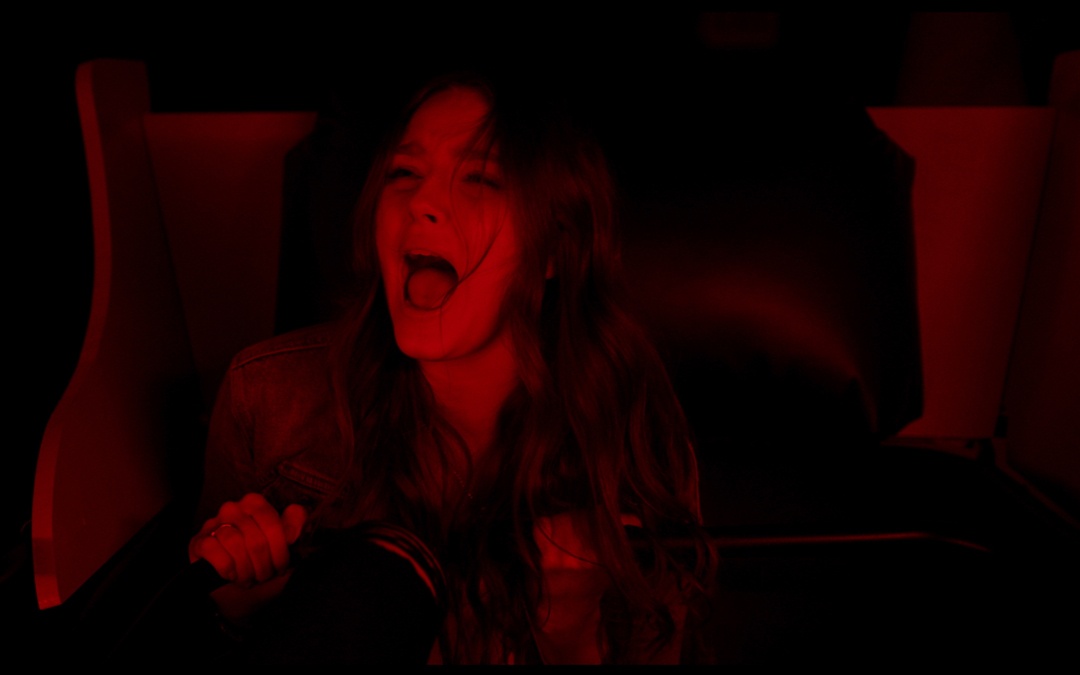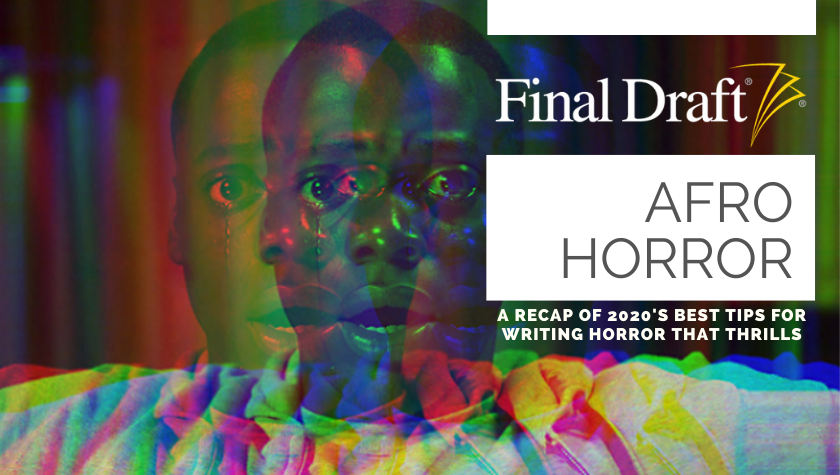Afro Horror: How To Build Tension In Your Horror Script
September 4, 2020
To paraphrase my good friend, writer-director Jeff Howard, during our recent virtual interview, horror and comedy are twins separated in the womb. They both rely on tension and release. Never have truer words been spoken. No wonder they pay him the big bucks! Yes, horror and comedy are, in fact, siblings. Typically, they both should run about ninety minutes, structurally depend on a clear set-up and punchline, and cannot function without tension, tension, tension.
A good horror script won’t have to visually rely on its monster or big bad to scare the audience; as the Master of Horror, Alfred Hitchcock, famously said, “There is no terror in the bang, only in the anticipation of it.” Think of the moment right before the protagonist goes to shut the refrigerator door or medicine cabinet. It’s the anxiety of what may be hiding behind said door in the shadows that scares the audience—once the reveal happens (usually nothing. It’s a lazy trope, don’t do it), the fear is gone, and the audience relaxes, waiting for the next set up.
So, how do you achieve that in your script? Here are three tips on how to build tension.
- LAYER YOUR STAKES
This is the first step in any efficient story building. But layering your stakes in the set-up is absolutely necessary in horror. *SPOLIER ALERT!* In the pilot episode of Misha Green’s Lovecraft Country on HBO, main characters Atticus (Tic), Letitia and Uncle George find themselves on a mission to find Tic’s missing father by traveling through the Jim Crow south in the 1950s—while also being chased by monsters and demons. But the best scene in the pilot didn’t have any “monsters” at all. Instead, it had a whole lot of tension. The scene begins with the three main characters finding themselves straddling city limits in a Sundown Town (an area under Jim Crow segregation laws that wouldn’t allow Black people to stay in their town past sundown. Usually they were shot or jailed if they were caught past “curfew.”) While the group is close enough to the town’s border where they would be safe, the police officer threatens to pull them over if they speed—in a 25 mile per hour zone—and the sun is going down QUICKLY. Talk about tension. The sequence lasts about five minutes and it is terrifying because of the stakes Green lays out so perfectly in the set up. In the end, the group makes it past the city limits just as the sun goes down, only to be attacked by vampires moments later, which is the real punch. Green keeps the audience on edge during the Sundown Town sequence, releases us for a moment to think the characters are safe, then almost immediately thrusts us into a new fright. Tension, release. Tension, release. If your script’s scare isn’t punching as hard as it should, it’s because you’re missing layered stakes from your tension building.
I love to use this exercise in my writers’ group, Writers Mob. What are stakes, really, except a literary term for anxiety? If you’re anything like me, you’re constantly thinking of the worst possible thing that can happen to you at all times. Thanks, anxiety! So, imagine you’re in your house. Then you trip and hurt your ankle. Then an earthquake hits. Then the building collapses around you. Then you try to call for help, but your phone’s been crushed. Then you try to scream for help, but no one can hear you because of all the rubble. Then you try to crawl out, but oops—that damn ankle you hurt earlier. Then to top it off, you have two minutes to get out of the house before it collapses completely. Stakes are simply one anxious thought layered on another. Your character needs stakes to give the audience significant tension, and the best stakes will have some sort of time limit attached. Audiences love a good countdown and it makes for good tension. In Lovecraft Country, the physical sun doing down is our clock. In my film, Deadly Dispatch, Tiffany has to find her best friend’s killer in three days, or the case will be closed for good. Layer up the stakes for your character and the tension will rise. Speaking of characters…
- CRAFT COMPELLING CHARACTERS
Howard also pointed out that we have to give a damn about the characters, or the rest of the story won’t matter. Tension and release only works when the audience actually gives a damn about what’s going to happen to the character. Take scream queen, Sidney Prescott (Scream). We care about Sidney. We root for her. No matter how many Ghost Faces she battles, we always want her to evade her killers. In horror, your protagonist (usually female) will be your final girl—but you’re going to need to take her to hell and back. Imagine if we didn’t care if she lived or died? How flat that would be? No matter how scary the big bad is, if we don’t care about the characters, the story doesn’t work. Spending time in your first act to show us why we need to care about this person is crucial. How are they with their family? Do they have family? Are they a good person? Do they deserve better? Are they a fighter? In 2019’s Ready or Not, an unexpecting newlywed must survive the night during a wicked game between her new in-laws. Now, what if we didn’t care about Grace, played by the wickedly charming Samara Weaving. What if she wasn’t this loveable, sweet, funny, kind and all-around bad ass bride that she is? We would literally be rooting for her new family to kill her and what kind of tension would that bring? The tension in Ready or Not is dependent on our connection to Grace—it’s literally her against everyone else and we root for her to win it all. You need the audience to not necessarily be on your protagonist’s side, but care about what happens to them. - RELEASE AND REPEAT
It’s important to note that the audience cannot live in a perpetual state of fear. You must release them so they can stick with story (and have those moments of caring for your protagonist when they can actually breathe). Most of you reading this are horror fans like me, and horror fans are ride or die. The bigger the kills, the scarier the jumps, we’re in it. BUT, we need a little relief, too. How else are we supposed to eat our popcorn if we’re constantly holding our breath? Now, once you’ve built your tension and hit your bang (whether that’s a reveal of a monster or a false scare) give your audience the time to recoup and feel “safe” again…and then remove that safety and swiftly. Do this over and over again as much as you want, but absolutely give space in between so we can A) get context clues for the ending where needed and B) move the story forward.
Horror writers are like a sick God, we giveth and we taketh away. We hold the power to make our audience feel safe, and then take that away…and then give it back like a parent handing over candy to a begging child. Your audience will be begging for more pain if you give it to them in small doses. Don’t burn them out too soon!
Just as in comedy, the set up to the punchline is the makeup of the joke. The same applies in horror: The set up in the tension is the makeup of the scare. It’s a delicate balance between informing the audience with story and scaring them with that story. If you can’t feel the tension in the script, you won’t be able to feel it in the film. Luckily, if you’re still in script phase, it’s not too late! You can go back and fix it right now. Go on…don’t be afraid.
Written by: Sade' Sellers
Sade Sellers is a screenwriter and producer based in Burbank, California. Originally from Michigan’s capital, Lansing, Sade’ has been working in the entertainment industry since 2009. In 2017, Sade’ was a finalist for Tv One’s Screenwriting competition for her teleplay The Replacement. This achievement motivated the network to hire her as a writer for their upcoming movie of the week event, Deadly Dispatch, which premiered on the platform in the summer of 2019. Through that production process, Sade’ met casting director Leah Daniels-Butler who was in the midst of staffing her production company, 1oneninety5. Sade’ then rose to the role of Vice President of Content Acquisitions and Development and spent the next year learning the ecosystem of film and television development from pitching to production. Using that experience, and bound at home due to COVID-19, Sade’ made a return to her first love, screenwriting, utilizing her free time to write new content. www.sadesellers.com- Topics:
- Discussing TV & Film




